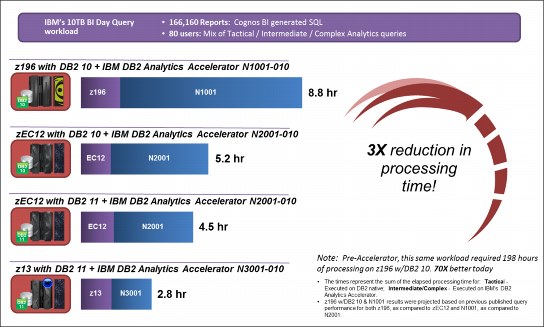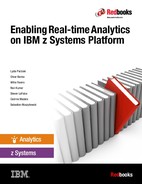


Acceleration for descriptive analytics: IBM DB2 Analytics Accelerator value with IBM Cognos BI
Delivering information fast is the objective of putting in place an analytics solution: a set of data reference architecture (or data lake) concepts and methodology, added by software products hosted on a strong infrastructure able to use those sets of technical solutions.
The analytics solution covers several stages of data analysis, such as these:
•Descriptive analytics: What happened?
•Diagnostic analytics: Why did it happen?
•Predictive analytics: What might happen in the future?
•Prescriptive analytics: How should we respond to those potential future events?
These stages are the strong foundation for a company to start their cognitive transformation.
Because a majority of business analytics (most notably social analytics) are descriptive, this chapter focuses on descriptive analytics and demonstrates the value that IBM z Systems platform can bring to a descriptive solution.
This chapter contains the following topics:
7.1 Descriptive analytics
Descriptive analytics are the most commonly used and most well understood type of analytics. The goals are to categorize, characterize, consolidate, and classify data. Descriptive analytics techniques are most commonly applied to structured data, although numerous efforts have been made to extend their reach to unstructured data, often through the creation of structured metadata and indices. Descriptive analytics help provide an understanding of the past and also events occurring in real-time.
The descriptive analytics tool must be a unified workspace for the entire organization that can be used to achieve these results:
•Answer key business questions.
•Explore all types of information from all angles to assess the current business situation.
•Analyze facts and anticipate tactical and strategic implications by shifting from viewing to more advanced, predictive, or what-if analysis.
•Collaborate to establish decision networks to share insights and drive toward a collective intelligence.
•Provide transparency and accountability to drive alignment and consensus.
•Communicate and coordinate tasks to engage the right people at the right time.
•Access information and take action anywhere, taking advantage of mobile devices and real-time analytics.
•Integrate and link analytics in everyday work to business workflow and process.
As the descriptive solutions have democratized the information access, they are really the entry point for information delivery and challenge the host infrastructure every day: scalability, performance, and reliability and the key non-functional requirements that the platform must rely on.
IBM Cognos Business Intelligence is the descriptive solution tool, hosted on IBM z Systems (for Linux on z Systems and z/OS) that fulfills scalability, performance and reliability requirements.
7.2 IBM Cognos Business Intelligence
IBM Cognos Business Intelligence (BI) helps your organization make smarter decisions, achieve better results, and gain a deeper understanding of trends, opportunities, weaknesses, and threats. With Cognos BI, you can explore any data, in any combination, over any time period, and with a broad range of analytics capabilities.
IBM Cognos 10 delivers a revolutionary new experience and expands traditional business intelligence (BI) with planning, scenario modeling, real-time monitoring, and predictive analytics.
Cognos 10 provides the following analytic capabilities:
•Query, reporting, and analysis through a Cognos BI server or interactive offline activity reports
•Scorecarding
•Dashboarding
•Real-time monitoring
•Statistics
•Planning and budgeting
•Collaborative BI
For more information about IBM Cognos Business Intelligence v10.1.1, see this web page:
7.3 IBM Cognos BI 10 and DB2 Analytics Accelerator and z13
The descriptive analytics solution is a huge consumer of data and huge provider of information for the line of business. The IBM DB2 Analytics Accelerator brings value for this typical descriptive analytics solution:
•Dramatically improves query response up to 2000X faster to support time-sensitive decisions.
•The descriptive analytics solution comes at the right time with low latency and provides trusted and accurate results.
Figure 7-1 shows analytics reports and workloads from a typical day.

Figure 7-1 Typical analytical reports and workloads
With IBM DB2 Analytics Accelerator, the large workload shown in Figure 7-1 will be accelerated, thus putting less stress on the system and freeing resources for other workloads.
Consider the following information about workload performance improvements shown in Figure 7-1:
•DB2 v11 provided a greater than 30% improvement over DB2 v10.
•Improvement was for the native DB2 portion of the workload because of significant improvements in DB2 access paths, in-memory enhancements, and query parallelism.
•The IBM z13 provided approximately a 30% improvement over the zEC12.
Figure 7-2 shows a comparison of hardware and software and the query workload improvements.

Figure 7-2 Hardware and software workload performance comparison
IBM Cognos BI, powered by IBM DB2 Analytics Accelerator on IBM z13 allows a descriptive analytics solution to be reliable, scalable, secure, and cost-efficient.
Figure 7-3 shows how many more reports per minute can be created on the IBM z13 using data acceleration and IBM Cognos BI.

Figure 7-3 Reports per minute
Descriptive analytics does provide significant insight into business performance and enables users to better monitor and manage their business processes.
IBM Cognos BI 10 with IBM DB2 Analytics serves as a first strong foundation for an analytics solution to go to predictive or prescriptive analytics.
For more technical information, see the following publications:
•Optimizing DB2 Queries with IBM DB2 Analytics Accelerator for z/OS, SG24-8005
•IBM Cognos Business Intelligence V10.1 Handbook, SG24-7912
..................Content has been hidden....................
You can't read the all page of ebook, please click here login for view all page.
